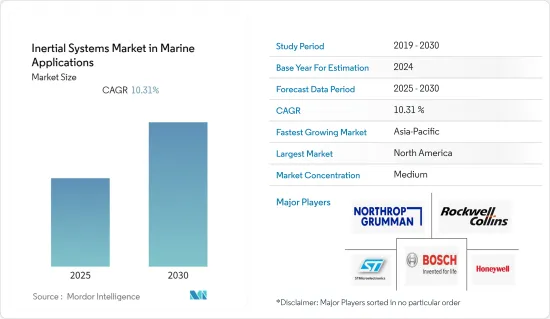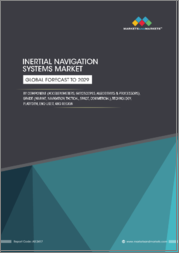
|
시장보고서
상품코드
1640351
해양 분야 관성 시스템 : 시장 점유율 분석, 산업 동향과 통계, 성장 예측(2025-2030년)Inertial Systems in Marine Applications - Market Share Analysis, Industry Trends & Statistics, Growth Forecasts (2025 - 2030) |
||||||
해양 분야 관성 시스템 시장은 예측 기간 동안 10.31%의 연평균 복합 성장률(CAGR)로 추이할 전망입니다.

주요 하이라이트
- MEMS 기반 솔루션은 에러 특성 개선, 환경 안정성, 대역폭 확대, G 감도 개선, 복잡한 퓨전 및 센서 에러 모델링 알고리즘을 실행하기 위한 임베디드 컴퓨팅 파워에 대한 액세스 증가로 지난 몇 년간 네비게이션 분야에서 인기를 얻고 있습니다. 공급업체는 FOG에서 MEMS 기술로 전환하고 있으며, 배열 안테나 안정화 분야도 이 추세를 따를 것으로 전망됩니다.
- MEMS 기반 네비게이션 시스템 가격이 1,000달러인 점은 3만 달러 이상인 기존 FOG 또는 RLG 네비게이션 시스템과의 비용 차이로 MEMS 기반 시스템의 성장을 가속하는 주요 요인 중 하나입니다. 그러나 시장에 나와 있는 다른 시스템에 비해 FOG 및 RLG 기반 솔루션은 더 높은 정확도를 제공합니다.
- 또한 모션 센싱을 기반으로 한 애플리케이션 증가도 시장을 견인하고 있습니다. 센서 관련 부품의 소형화가 진행되어 고기능 센서 개발이 집중되고 있습니다. 예를 들어, Xsens는 MTi 1 시리즈의 모션 센싱 관성 측정 유닛(IMU) 모듈을 개선하여 롤, 피치, 요의 측정 정확도를 향상시키고 다양한 에너지 및 인프라 프로젝트에서 1세대 제품보다 기계적 스트레스에 대한 내성을 높였습니다.
- INS 시스템은 구매, 운영, 유지 보수를 포함한 비용이 높고 방열이나 시간이 지남에 따라 증가하는 항법 실수 등의 단점이 있습니다. 크기, 무게 및 전력 기준은 기술 발전으로 시간이 지남에 따라 감소하고 있지만 여전히 GPS 수신기 기준보다 높습니다.
- COVID-19의 발생으로 많은 상용 및 비상업 운항이 중단되었습니다. 해운 및 해사 부문은 팬데믹에 의해 심각한 영향을 받은 업계 중 하나입니다. 안전상의 이유와 COVID-19의 유행을 막기 위해 노동력이 삭감되고 있기 때문에 팬데믹에 의해 해운 및 해사 부문은 최악의 상황에 놓여져 있습니다.
해양 분야 관성 시스템 시장 동향
고정밀 관성 시스템에 대한 요구 증가가 시장 성장을 견인
- 해양 관성 시스템은 자율수중로봇(AUV), 무인수중로봇(UUV), 무인수상정, 원격무인잠수정(ROV) 등의 무인해양 및 해상시스템에 방위, 위치, 속도 데이터를 제공합니다. 수상 및 수중에서의 자율운항은 정확한 방위, 속도, 피치, 롤, 그리고 위치 데이터에 의존하기 때문에 선박용 INS는 필수적입니다. 또한 UUV와 USV가 파도가 많은 해역에서 위치와 안정성을 유지하고 ROV 운영자에게 자신의 위치 정보를 제공하는 데 도움이 됩니다.
- 예를 들어 실리콘 센싱 시스템즈는 급속히 확대되는 해외 분야 수요에 부응하기 위해 이러한 기술을 활용해 온 오랜 역사가 있습니다. 이 회사는 다양한 하이테크 시스템을 위해 업계를 선도하는 MEMS 기반 관성 센서를 설계 및 제조합니다. 선박, 잠수함 및 기타 해상 차량에서 정확한 움직임과 위치를 모니터링하고 제어하는 데 필요한 시스템에는 MEMS 관성 센서가 포함됩니다.
- MEMS 기술의 개발과 운항 정밀도에 대한 요구 증가가 관성 시스템의 성장을 가져왔습니다. 네비게이션 시스템은 큰 시장 점유율을 예상하고 있습니다. 해군 응용분야에 이용되는 관성 측정 장치(IMU)는 단기 운항용으로는 0.05-0.5°/h의 바이어스 안정성을 갖고, 고급 운항용에는 0.0001-0.01°/h의 바이어스 안정성을 가지고 있습니다.
아시아태평양이 시장의 급성장 지역이 될 전망
- 아시아태평양에는 세계에서 가장 경제 성장률이 높은 중국과 인도가 있습니다. 국제 무역의 대부분을 해상 루트로 차지하는 이들 국가의 상업적 교류가 해상 운송 사업의 성장을 뒷받침하고 있습니다.
- 세계 컨테이너 항만 하역 사업의 동향은 아시아가 세계 무역과 운송에서 압도적인 지위를 차지하고 있음을 보여줍니다. 아시아 국가들은 지역 내 무역의 상당한 증가를 목격하고 있지만, 대부분은 제조 무역으로 인한 것으로 이는 부품이 아시아 전역의 여러 곳에서 생산되고 다른 곳에서 조립되는 분산 생산 공정을 반영하고 있습니다.
- 수요 증가의 대부분은 아시아에서 발생하고 있으며 에너지 정책의 지속적인 변화와 호주와 미국의 수출 능력 확대가 이를 뒷받침되고 있습니다. 기업이 복잡하고 혁신적인 가속도계 개발에 투자하고 있기 때문에 이 지역에서는 새로운 고성능 가속도계가 개발되고 있습니다. 무역은 해상 운송을 바탕으로 증가할 전망입니다.
해양 분야 관성 시스템 산업 개요
다양한 관성 시스템 솔루션 제공 업체가 있기 때문에 시장은 부분적으로 단편화되어 있습니다. 그러나 공급업체는 지속적으로 제품 개발에 주력하여 지명도와 세계 시장의 존재감을 높이고 있습니다. 각 회사는 또한 시장 견인력과 시장 점유율 확대를 위해 전략적 제휴와 인수를 실시하고 있습니다. 주요 기업은 Honeywell International Inc., Bosch Sensortec GmbH, Northrop Grumman Corporation, ST Microelectronics 등입니다.
- 2022년 9월 - Groupe Gorge는 iXblue의 인수를 통해 큰 성과를 달성했다고 발표했습니다. ECA 그룹과 iXblue의 합병으로 로봇 공학, 해양, 네비게이션, 항공우주 및 광자학 분야 유럽 하이테크 산업 리더 기업이 출현하였습니다. 고객은 iXblue와 ECA 그룹에서 간단한 부품부터 복잡한 시스템에 이르기까지 복잡한 지형에서 중요한 활동을 지원받게 됩니다.
기타 혜택
- 엑셀 형식 시장 예측(ME) 시트
- 3개월간의 애널리스트 지원
목차
제1장 서론
- 조사의 전제조건과 시장 정의
- 조사 범위
제2장 조사 방법
제3장 주요 요약
제4장 시장 인사이트
- 시장 개요
- 밸류체인/서플라이체인 분석
- 업계의 매력도 - Porter's Five Forces 분석
- 신규 참가업체의 위협
- 구매자의 협상력
- 공급기업의 협상력
- 대체품의 위협
- 경쟁 기업간 경쟁 관계의 강도
- COVID-19의 업계에 대한 영향 평가
제5장 시장 역학
- 촉진요인
- MEMS 기술의 출현
- 모션 센싱에 기반한 애플리케이션 증가
- 억제요인
- 통합 드리프트 에러
제6장 시장 세분화
- 컴포넌트별
- 가속도계
- IMU
- 자이로스코프
- 자력계
- 자세 헤딩
- 레퍼런스 시스템
- 지역별
- 북미
- 유럽
- 아시아태평양
- 세계 기타 지역
제7장 경쟁 구도
- 기업 프로파일
- Honeywell International Inc.
- Northrop Grumman Corporation
- Rockwell Collins
- Bosch Sensortec GmbH
- ST Microelectronics
- Safran Group
- SBG Systems
- Raytheon Anschtz GmbH
- KVH Industries Inc.
- Silicon Sensing Systems Ltd
- Vector NAV
제8장 투자 분석
제9장 시장의 미래
CSM 25.02.17The Inertial Systems Market in Marine Applications Industry is expected to register a CAGR of 10.31% during the forecast period.

Key Highlights
- MEMS-based solutions have gained popularity in the navigation sector over the past few years due to improved error characteristics, environmental stability, increased bandwidth, improved g-sensitivity, and the growing accessibility of embedded computing power to run sophisticated fusion and sensor error modeling algorithms. Vendors are switching from FOG to MEMS technology, and antenna array stabilization applications appear to follow suit.
- The cost differential between MEMS-based systems and conventional FOG or RLG navigation systems, which cost over USD 30,000 instead of USD 1,000 for MEMS-based navigation systems, is one of the main factors driving growth in MEMS-based systems. However, compared to other systems on the market, FOG- and RLG-based solutions provide more precision.
- The market is also being driven by an increase in applications based on motion sensing. The ongoing downsizing of sensors and related components is concentrating progress toward sophisticated function sensors. For instance, Xsens improved versions of its motion-sensing Inertial Measurement Unit (IMU) modules from the MTi 1-series, which offer improved roll, pitch, and yaw measurement accuracy and higher tolerance of mechanical stress compared to the first generation of the product in various energy and infrastructure projects.
- The price of INS systems, including purchase, operation, and maintenance, is a drawback. Other drawbacks include heat dissipation and escalating navigational mistakes over time. The size, weight, and power criteria are still greater than those for GPS receivers, although they decrease over time as technology advances.
- Numerous commercial and non-commercial operations have been put on hold due to the COVID-19 outbreak. The shipping and maritime sector is one of the businesses severely impacted by the outbreak. Since their workforces have been curtailed for safety reasons and to stop the spread of COVID-19, the pandemic has left the shipping and maritime sectors in the worst conceivable position.
Marine Applications Inertial Systems Market Trends
Evolving Need for High-Accuracy Inertial Systems Driving the Growth of the Market
- Marine inertial systems provide orientation, position, and velocity data to unmanned marine and maritime systems, such as autonomous underwater vehicles (AUVs), unmanned underwater vehicles (UUVs), unmanned surface boats, and remotely operated vehicles (ROVs). Since autonomous surface and underwater navigation depend on exact heading, velocity, pitch, roll, and location data, marine INS is essential. They also help UUVs and USVs maintain their station and stability in choppy waters while providing information to ROV operators on where their craft should be.
- Silicon Sensing Systems, for instance, has a long history of using these technologies to meet the demands of quickly expanding offshore sectors. The company designs and manufactures industry-leading MEMS-based inertial sensors for a range of high-tech applications. The systems required to monitor and control precise motion and position on ships, submarines, and other maritime vehicles include MEMS inertial sensors.
- The development of MEMS technology and the increased demand for navigational accuracy can be credited with the growth of inertial systems. A sizeable market share is anticipated for navigational systems. Inertial measurement units (IMUs) utilized for naval applications have bias stability of 0.05-0.5 °/h for short-term navigation and 0.0001-0.01 °/h for high-grade navigation.
Asia-Pacific is Expected to be the Fastest-Growing Region in the Market
- The Asia-Pacific region includes China and India, two of the world's economies with the highest growth rates. Commercial interactions between these nations, whose maritime routes make up the majority of international commerce, drive the growth of the marine transportation business.
- Trends in container port-handling operations worldwide show Asia's dominant global trade and transportation position. Asian countries are seeing a major increase in intra-regional trade, mostly driven by manufacturing trade and reflecting dispersed production processes where components are produced in many locations throughout Asia and assembled in another.
- Most of the increased demand came from Asia, helped by ongoing changes to energy policy and expanded export capacity in Australia and the United States. New, high-performance accelerometers are developing in the region as businesses invest in creating complex and innovative accelerometers. Trade is expected to increase, boosted by marine transportation.
Marine Applications Inertial Systems Industry Overview
The market is partially fragmented due to the presence of various inertial systems solution providers. However, vendors consistently focus on product development to enhance their visibility and global presence. The companies are also undergoing strategic partnerships and acquisitions to gain market traction and increase market share. The key players are Honeywell International Inc., Bosch Sensortec GmbH, Northrop Grumman Corporation, ST Microelectronics, etc.
- September 2022 - Groupe Gorge announced that the acquisition of iXblue was a significant accomplishment. The merger between ECA Group and iXblue will help in the emergence of a European high-tech industrial leader in robotics, marine, navigation, aerospace, and photonics. Customers will receive a special offer from iXblue and ECA Group that ranges from simple components to intricate systems to support important operations in challenging terrain.
Additional Benefits:
- The market estimate (ME) sheet in Excel format
- 3 months of analyst support
TABLE OF CONTENTS
1 INTRODUCTION
- 1.1 Study Assumptions and Market Definition
- 1.2 Scope of the Study
2 RESEARCH METHODOLOGY
3 EXECUTIVE SUMMARY
4 MARKET INSIGHTS
- 4.1 Market Overview
- 4.2 Value Chain/Supply Chain Analysis
- 4.3 Industry Attractiveness - Porter's Five Forces Analysis
- 4.3.1 Threat of New Entrants
- 4.3.2 Bargaining Power of Buyers
- 4.3.3 Bargaining Power of Suppliers
- 4.3.4 Threat of Substitute Products
- 4.3.5 Intensity of Competitive Rivalry
- 4.4 Assessment of COVID-19 Impact on the Industry
5 MARKET DYNAMICS
- 5.1 Market Drivers
- 5.1.1 Emergence of MEMS Technology
- 5.1.2 Increasing Applications Based on Motion Sensing
- 5.2 Market Restraints
- 5.2.1 Integration Drift Error
6 MARKET SEGMENTATION
- 6.1 By Component
- 6.1.1 Accelerometers
- 6.1.2 IMUs
- 6.1.3 Gyroscopes
- 6.1.4 Magnetometer
- 6.1.5 Attitude Heading
- 6.1.6 Reference Systems
- 6.2 By Geography
- 6.2.1 North America
- 6.2.2 Europe
- 6.2.3 Asia-Pacific
- 6.2.4 Rest of the World
7 COMPETITIVE LANDSCAPE
- 7.1 Company Profiles
- 7.1.1 Honeywell International Inc.
- 7.1.2 Northrop Grumman Corporation
- 7.1.3 Rockwell Collins
- 7.1.4 Bosch Sensortec GmbH
- 7.1.5 ST Microelectronics
- 7.1.6 Safran Group
- 7.1.7 SBG Systems
- 7.1.8 Raytheon Anschtz GmbH
- 7.1.9 KVH Industries Inc.
- 7.1.10 Silicon Sensing Systems Ltd
- 7.1.11 Vector NAV















